As part of the 100 Events to commemorate the 100th Anniversary of WW1 called Oxford Remembers, Scott Gillies, the Curator from the Ingersoll Cheese & Agricultural Museum, invited author, historian and veteran Grant Smith to speak on Thursday May 28, 2015 to a small gathering on how to look for military relatives who served during World War One. The discussion went well with the Museum’s theme at that time, Reaction & Recruitment: Oxford Goes to War.
After reading a poem, Scott Gillies reported that Grant Smith, a Delhi native, served as a helicopter pilot with the Canadian Armed Forces who has a passion for the two World Wars. Grant Smith explained the title of his presentation. He saw the movie Dead Poet’s Society where one of the students touched a war memorial and said “they still have names.” Grant wanted to dedicate this to Private Andrew Miller, a soldier’s wish, who was killed in action in June 2010. He had written to his mother “tell them who I was and ask them never to forget me.”
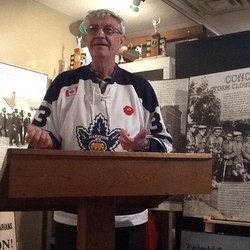
Fast forward 50 years later to 2004; Grant once again saw the Crown on the Maple Leaf. He was asked by his son to be an Assistant Coach in the Markham Minor Hockey Association. The Markham sweaters had the crest of the Crown superimposed on a
Maple Leaf but no one knew why. Then a revelation! In June 2013, a select Markham major Bantam hockey team went to Maple Leaf Gardens where Grant Smith heard “the holy grail” speech on Conn Smythe.
On how he [Conn Smythe] had built Maple Leaf Gardens in the middle of the
Depression opening it in 1938. Scattered around the dressing room are hockey
bags that bore the insignia of the Crown superimposed on a Maple Leaf. And
in that moment everything I knew about the First World War converged with
my passion for the Toronto Maple Leafs and I shouted out to the room: "AND
CONN SMYTHE WAS AT VIMY RIDGE". And so began the quest for the answer
as to why the Crown and Maple Leaf was on a Markham sweater.
Maybe if both Canadians and Toronto Maple Leaf players knew this history and the insignia, then maybe the players would play better and more Canadians would be fans?
Vimy Ridge
Grant Smith then explained how during World War I the French and British failed to take Vimy Ridge on three different occasions and in 2 1/2 years and lost over 65,000 men. Vimy Ridge was a 7- kilometer long tract where Hill 145 was located which had a height equivalent to a 50-story building. On top of this hill the Vimy Memorial would later stand. The land flatten out to Farbus Woods where the Germans had their big guns. In 1917, it was Canada's turn to try to take Vimy Ridge.
For three months the Canadian soldiers underwent intensive training where each battalion would be responsible for taking a segment of the German trenches along the Ridge. At 5:30 a.m. on Easter, Monday April 9, 1917, the Canadian soldiers began their attack at Vimy Ridge with two waves and 985 Canadian and British artillery guns. The first wave consisted of 20,00 soldiers in 25 Battalions. It was the 50th Anniversary of Canadian Confederation. Grant illustrated this by using the audience as waves of Canadian Corps. "The fabric of the men and women of the Canadian army was a varied as it is today: Native Canadians, Greeks, Italians, Chinese, Hungarians, Poles, Macedonians, Ukrainians, Indians, French, English, Scots and Irishmen. But they all gave their nationality as Canadian. It was possible the largest gathering of Canadians ever."
Describing the battlefield
Through his research, Grant Smith knew that the 168 Oxford County and the 133rd Norfolk Battalions were scattered throughout the army with 500 Norfolk men who participated in the battle of Vimy Ridge along with Artillery Officer Conn Smythe. Grant read some letters from these soldiers to family members back home describing the battle.
Easter Sunday, April 8 - Lt. Frank Smith of Townsend, 2nd Battalion:
Dear Father:
It is Easter Sunday. We have just had our dinner and I am writing this in the
field surrounded by thousands of other Canadians. It is a beautiful day. The
sun is bright and we are all hoping tomorrow will be as nice for we are looking
forward to its being the biggest day in Canadian history. I am proud to be here
to do my little bit with the rest of the boys. By the time you get this letter you
will know what has happened. My trust in God and all is in His hands. In order
to win this war and destroy the awful menace that is at our gate, sacrifices must
be made and lives laid down. (See video of Grant reading this letter.)
| Grant cited that "the infantry had 3 minutes to walk forward toward their own exploding shells, after which the guns were elevated and fired another 90 meters in front of the attacking line." Canadian pilots described the battle as "Vimy Glide." The objective was to take the Red Line that laid half way to the final objective with the second wave attacking to its conclusion. |
 Oxford & Norfolk Counties' Battalions
Oxford & Norfolk Counties' Battalions The War Diary of the 14th Battalion
Grant read another Soldier's letter:
Major Guy McDowell of North Walsingham, Princes Patrica Canadian Light
Infantry
Dear wife: The Canadian troops went over the top on Monday April 9th, at
5:30 o'clock, preceded by a wonderful barrage from the artillery and machine
guns. It was so perfect that the German troops did not have a chance to get out
of their dugouts before our men were at their trenches. It is impossible to imagine
what heavy barrage it like. The noise is terrible, and there appears to be a sheet
of flame moving toward the enemy. When you realize that some of the guns used
are four to five miles in the rear and that the slightest mistake in elevation or an
error in judging the wind would make the shells fall short and kill our own men,
shows how serenity artillery has become.
As for our own battalion, several things out of the ordinary happened which
might interest you. One was the band played the men over the humping off
trench, as it is called. This is a pipe band and is perhaps the only pipe band
in France not with a highland battalion. The city of Winnipeg presented the
P.P.C.L.I. with this band when the battalion was first recruited, and it has been
with them ever since. Also the men actually kicked a football across the contested
ground. I had read such things happening, but thought it was mostly paper talk.
(See video.)
Grant also read several letters from the War Diary of the 14th Battalion which included Norfolk stories of the advance. According to the war diary's by 7:10 a.m. the Red Line objective was reached; 16 Norfolk men had been killed. After a two hour break the second wave began their final assault on Farbus Woods. By 2:00 p.m. the Canadians had taken Vimy Ridge. Four Norfolk men in the 4th Battalion were killed in action.
Vimy Ridge taken
With a choked voice, Grant read an expert from the newspaper from that time:
Vimy was the pinnacle of Canadian military achievement. Canada
could now take its place among the nations of the world. But what
a price! While there was breast-thumping pride throughout Canada,
3,598 families were left to mourn the death of a father, son or brother
lost on the slopes of Vimy. Over 10,000 more were wounded.
From his research, Grant Smith reported that 22 Norfolk men were killed; 15 were buried in the Nine Elms Cemetery in Belgium along with two Oxford County men. The two Oxford County soldiers killed were Ernest Hanfield and Private Thomas Cussons. I had the distinct pleasure to be of sitting beside the latter's relative that was in the audience.
Grant Smith further reported that the Canadian soldiers "will go on to win battles at Hill 70, Passchndaele, Amiens, Canal du Nord and establish themselves as the most potent 'shock troops' in the war. In the end over 67,000 will die.
And they all had one thing in common - their Canadian cap badge that featured a Crown superimposed on a Maple Leaf. "
The Conn Smythe Story
After World War I, Conn Smythe bought a hockey team called the Toronto St. Patrick's in 1927 and renamed it the Toronto Maple Leafs. Grant read the following excerpt why Smythe chose the name:
The Maple Leaf to us, was the badge of courage, the badge that meant home.
It was a the badge that reminded us all of our exploits and the different
difficulties we got into and the different accomplishments we made. It
was a badge that meant more to us than any other badge that we could
think of... so we chose it... hoping that the possession of this badge
would mean something to the team that wore it and when they skated
out on the ice with this badge on their chest... they would wear it with
honour and pride and courage, the way it had been worn by the soldiers
of the first Great War in the Canadian Army.
Grant reported: "It is the same Maple Leaf that is engraved on the graves stones of our soldiers."
Bringing it Home
Grant returns to his story in the dressing room at the Markham ice rink. During their first hockey game Grant told the boys a short version of the above mentioned story. During their last game of the season with a a score of 1-1, Grant was asked by his son to give a pep talk. He said to the team: "Boys. You are taking the Maple Leaf to the top of the hill today and you are not stopping half way up. You're going all the way to the top." Grant said the team stormed out of the dressing room and won the game. Later, one boy told his mother that coming out of the dressing room they felt like soldiers.
Grant Smith cited that the moral of the story: "The Maple Leaf is our emblem. It is not some passive warm and cuddly symbol. It was baptized in our blood and will always lead from the front. If you are a Canadian, hockey imitates life. Our younger generation does listen to our stories and songs. We only need to take the time to tell them the words."
Like myself, the rest of the audience was in awe of Grant Smith's story. Someone made the comment that if this was the States, everyone would know of this history. How true. Every Canadian and hockey player for the Toronto Maple Leaf, should know the history of how the Maple Leaf became the insignia on the hockey jersey. I am sure this story would instil national pride with both the Toronto Maple Leaf players and Canadians who then would be proud to support their hockey team. For the players would play with pride and courage and the team would once again be a source of Canadian pride and Canadians could become "fanatical" Toronto Maple Leaf fans.
Oxford Remembers
Oxford Remembers Oxford's Own - Guide to 100 WW1 Commemorative Events happening in Oxford 2014 - 2018
Gallery of pictures from Grant Smith's presentation. (Pictures taken of the exhibit at the Museum and of Grant Smith's slide show were with consent and permission.) See videos.
Age shall not weary them, nor the years condemn.
At the going down of the sun and in the morning
We will remember them.” ~ From Poem “For the Fallen” by Robert Laurence Binyon







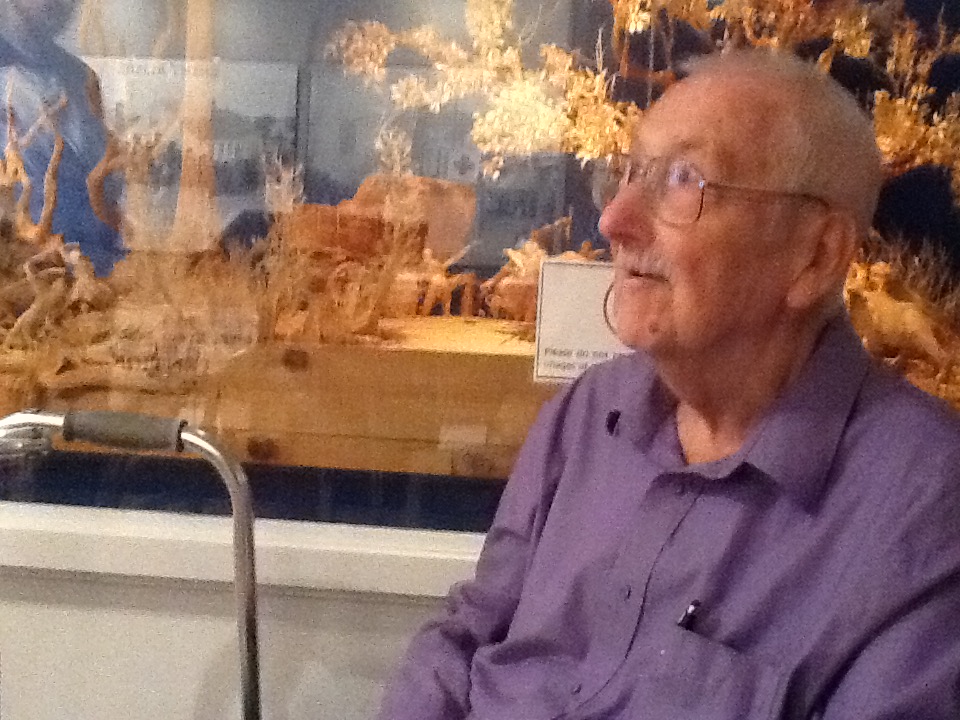









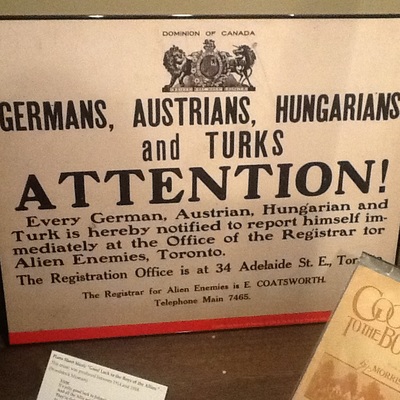
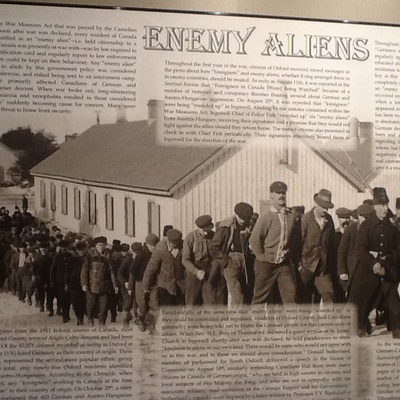








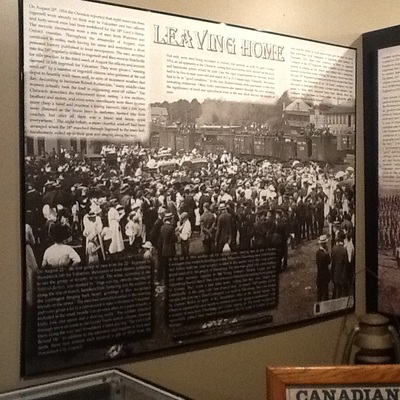














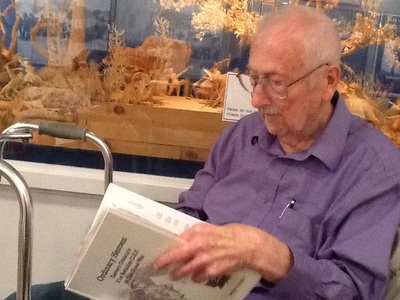



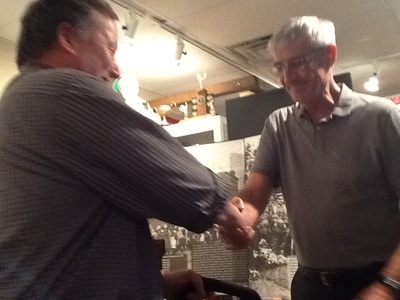







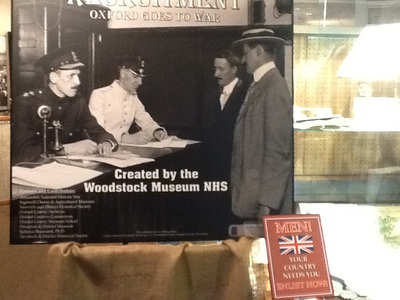

 RSS Feed
RSS Feed
